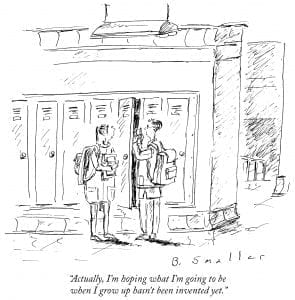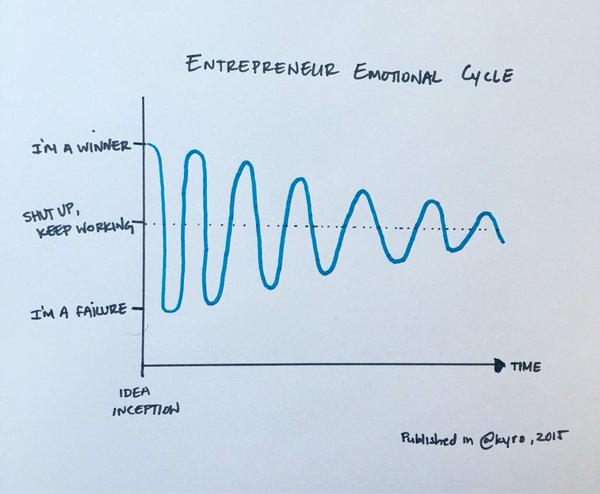Entrepreneurs need to invent their future: this requires a cycle of discovery, invention, growth, and renewal.
Discovery, Invention, Growth, and Renewal
“People often say that this or that person has not yet found himself. But the self is not something one finds, it is something one creates.”
Thomas Szasz in “The Second Sin” (1973)
Whether it’s creating your identity as an entrepreneur or a successful startup I think you follow a trial-and-error process of
- Discovery / Observation / Exploration
- Invention / Experimentation / Play
- Growth / Exploitation / Innovation
- Renewal / Abandonment / Reorganization
 Inventing the Future
Inventing the Future
“The future cannot be predicted, but futures can be invented. It was man’s ability to invent which has made human society what it is.
Dennis Gabor in “Inventing the Future” (1963)
To succeed as entrepreneurs we need to build firms that solve problems in a way that has not been invented yet. You can achieve this by:
- discovering new methods or technologies,
- by recombining existing elements in novel ways,
- by better processes or better execution of an existing approach such that it yields a qualitative or measurable difference for current customers,
- or by simplifying an existing offering so that it can better serve an existing or new category of customer.
The Impalpable Elations and Apprehensions of Growth
“Society at any moment is the stubborn retarded expression of mankind’s previous and partially collected experience. […]
I would argue most seriously that growth is a greater mystery than death. All of us can understand failure, we all contain failure and death within us, but not even the successful man can begin to describe the impalpable elations and apprehensions of growth.
When we can all agree […] that history is not foreseeable and the future is unknown, we must also agree that although society is a machine, it does not determine man’s fate, but merely processes nine-tenths of his possibilities on the basis of what society has learned from the past.”
Norman Mailer “On Lies, Power, and Obscenity” 1956 Village Voice column
I think because growth requires both the abandonment of old forms, habits, and structures and the exploration of new approaches–many of which do not prove viable–Mailer’s phrase “elations and apprehensions” captures the mental roller coaster of the entrepreneur. As does this diagram from Kyro Beshay (@kyro Jul-31-2015): “Data from the first 4 months of my ongoing research.”


I don’t think I have observed a damping of the oscillations when I look back 13 years, or at least the sensation of “I’m a winner” is always followed quickly by the need to “shut up and keep working.” Managing your emotions–elations and apprehensions–during the cycle of discovery, invention, growth, and renewal is one of the core challenges of persevering as an entrepreneur.
I would change Beshay’s “Shut Up, Keep Working” to the gentler phrasing of “Keep Calm and Carry On.” I think it’s important to do the “winning / losing” evaluation on infrequent intervals (e.g. quarterly). The challenge is to map out “how can long will it take to tell if plan A is not working” so you don’t re-evaluate too frequently. Make your plan B, the one you will shift to if plan A does not work up at the time you make plan A so you don’t end up at “plan A is not working, what the heck do I do now?” Also make plan A+ for how to increase your effort or investment in plan A to accelerate it further if it’s “winning.”
Renewal: To Do Something New, Stop Doing Something Old
Renewal requires abandoning what’s not working, reorganizing around what is still working, and restructuring to prepare for new opportunities you have discovered. It’s the least talked about and most challenging aspect of entrepreneurship because you are also letting go of expertise you have accumulated as an individual or as part of a team or organization.
“The key challenge in brainstorming is to let go of old ideas.”
Gijs van Wulfen
The ability to see a problem de novo or with newcomer’s eyes allows you to see what the experienced have overlooked. This structured approach to letting go of old ideas is what Peter Drucker advocates with his “organized abandonment” concept: if you were not already doing something today, knowing what you know now, would you start doing it. You need to do this to create the resources and management bandwidth to innovate.
“There is a need for organized abandonment: the systematic withdrawal of resources–money, but above all, people–from yesterday’s efforts. […]
Every product, every service–external and internal–every process, every activity needs to be put on trial every few years with the question: “If we weren’t in this already, would we go into it knowing what we now know?” […]
The time to ask these questions and act upon the answers is not when the institution is in trouble. It is while it is successful. For then it is most likely to have resources allocated to the past, to things that did produce, to goals that did challenge, to needs that were unfulfilled.”
Related Blog Posts
- Ebb and Flow A long term viable business model embraces ebb and flow: it organizes the abandonment of failed and obsolete products to enable an investment strategy for new growth that emphasizes experimentation in anticipation of a high rate of early small failures.
- Maintaining Perspective on the Entrepreneurial Roller Coaster
- Francis Adanza on the Entrepreneurial Roller Coaster
- Am I Making A Fool Of Myself?
- Sketching The Likeness Of An Imaginary Business
- Record to Remember, Pause to Reflect
- Minimum Viable Product: Enthusiastically Proceed Skeptically
Additional Context and Notes
- Quote Investigator: “We Cannot Predict the Future, But We Can Invent It“
- Maria Popova: Norman Mailer on the Rat Race of Success and What True Growth Means I discovered the Mailer quote in The Oxford Book of Aphorisms edited by John Gross, but discovered this post by Popova when I was searching for more context.
- Norman Mailer’s Village Voice column “On Lies, Power, and Obscenity” is collected in “Advertisements for Myself” and “Mind of an Outlaw“
- “Inventing The Future” cartoon licensed from Cartoon Bank for use in a blog post; Conde Nast TagID: CNCARTOONSs018159.jpg

Pingback: SKMurphy, Inc. Quotes For Entrepreneurs-October 2016 - SKMurphy, Inc.
Pingback: SKMurphy, Inc. Quotes For Entrepreneurs-November 2016 - SKMurphy, Inc.
Pingback: SKMurphy, Inc. Quotes For Entrepreneurs December 2016 - SKMurphy, Inc.
Pingback: Newsletter 2020 December: Withdrawal and Return - SKMurphy, Inc.
Pingback: Entrepreneurs Cannot Rely on a Cookbook or a Manual -